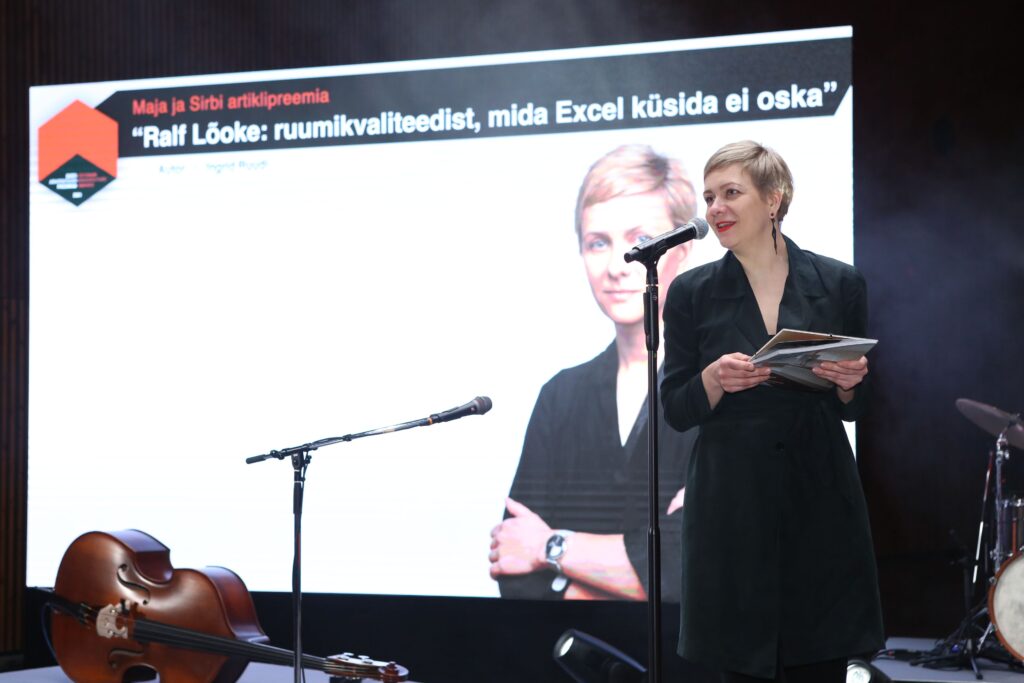The nominees and winners of this year’s Maja and Sirp Article Award were selected by historian, cultural critic and assistant professor at the University of Southern California Aro Velmet, who highlighted the articles’ bold takes on broader social issues.

Velmet notes that the nominees made an impression namely with their clear author’s position: ‘Reviews came up with generalisations that reached beyond the function of a particular building or part of urban space; exhibition overviews reflected confident choices’. Velmet also applauded the diversity of genres among the articles: ‘There were programmatic texts and historical overviews, reviews of buildings, exhibitions and books, interviews and problem stories, travelogues and reflections on personal experiences—and even “communal porn”, in a good sense’.
Winner of the Maja award

Ingrid Ruudi, ‘Ralf Lõoke on Spatial Quality Beyond Excel‘
‘On the face of it, what we have is a profile of one of the most successful Estonian architects. However, underneath we find an in-depth introduction to the philosophy and politics of space, together with concrete examples to illustrate it. Lõoke’s work focuses on integrating buildings with the surrounding space in order to comment on social relations and our use of space, or, as he puts it, “faith in the expressive power of architecture”’. – A.V.
Nominees of the MAJA award
Madli Maruste, ‘A Milky Way of Potential for Creative Space‘
‘Pärnu Raja kindergarten is examined through several different lens—as a pandemic space, creative space, spaceship, etc. The central tension with regard to the building lies between a philosophy of learning that emphasises the cultivation of play, irregularity and creativity, and our practice of designing educational institutions to have the function and architecture of a panoptic control institution’. – A.V.
Leonard Ma, ‘In the Long Run We Are All Dead‘
‘A review of „City Unfinished“, an exhibition at the Estonian Museum of Architecture. A good example of thoughtful criticism that goes beyond simply describing and evaluating the exposition to further develop the issues raised there. How has our thinking about urban planning evolved over the 20th century?’ – A.V.
Hannes Aava, ‘New Urbanism and Landscape Urbanism. The Ideological Battlegrounds of a More Sustainable Urban Space‘
‘An overview of two theoretical frameworks—new urbanism and landscape urbanism—in the era of climate change and inequality. Another well-illustrated and concise excursion into the history of thinking about space that reintroduces classical authors and presents vivid examples’. – A.V.
Ingrid Ruudi, ‘Adaptations. Estonian Architects Swept by the Winds of Transition’
‘A comprehensive analysis of the changes that took place in the field of architecture after the restoration of independence—a period when little was built, but many debates where held that largely set the agenda for the decades to come. Architects became less like independent creators and more like small entrepreneurs, but this made them struggle to retain their artistic image even more forcefully’. – A.V.
Winner of the Sirp award

Krister Kruusmaa, ‘The Natural History of Architecture’
‘Kruusmaa reviews the book Histoire naturelle de l’architecture by Swiss architect Philippe Rahm, which re-interprets the history of architecture as history of environment—many architectural solutions begin to look rather different when considered from the perspective of maintaining homeostasis. The issues that Rahm raises are linked with examples from Estonia, and the review concludes with a general discussion of environmental humanities more broadly’. – A.V.

Nominees for the Sirp award
Kaspar Kruup, ‘Smart City in a Pocket Won’t Save the World’
‘A pleasant article that combines the personal, local and global levels. Is smart city the magic wand for solving the climate crisis or simply some overhyped greenwashing? Kaspar Kruup discusses the issue through the example of his own housing cooperative that was granted funding to turn their “khrushchyovka” into a “smartovka”’. – A.V.
Ulla Alla, ‘Ready’
‘Are we building too much? Perhaps we should let our depreciated buildings simply fade way and become one with nature? Should we treat architecture more like nature—not an environment to be watched over and maintained, but rather a self-sufficient entity?’ – A.V.
Mattias Malk, ‘Almost a Kilometre of Almost Public Space’
‘A review of the new cruise terminal in Tallinn and the adjacent promenade. A good example of how a review of an architectural object can illuminate more general problems in urban planning. The central concept in the article is the acronym PEARU, standing for “peaaegu avalik ruum [an almost public space]”—a space that seems to belong to everyone, but where actually the real estate developer reigns’. – A.V.
Karin Bachmann, ‘The Second Coming of an Old and Forgotten Minority’
‘How should public space account for the interests of non-human animals? The essay raises a surprising and intriguing question that links up with current hot topics in the humanities, such as anthropocentrism and the environment. However, in doing so, it dives into concrete specifics—one does not find that too often in general interest periodicals’. – A.V.
Articles published in Maja no. 103–106, or Sirp between October 9th, 2020 and October 1st, 2021, were eligible to compete for the award.
Supported by Cultural Endowment of Estonia.
HEADER photo by Annika Haas
PUBLISHED: Maja 107 (winter 2022) with main topic Evolution or Revolution?





